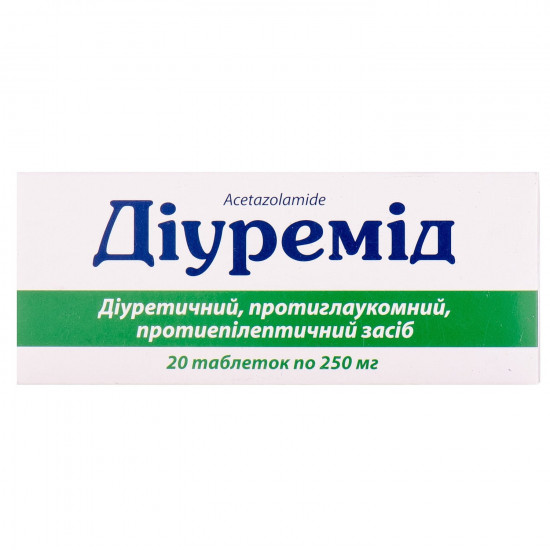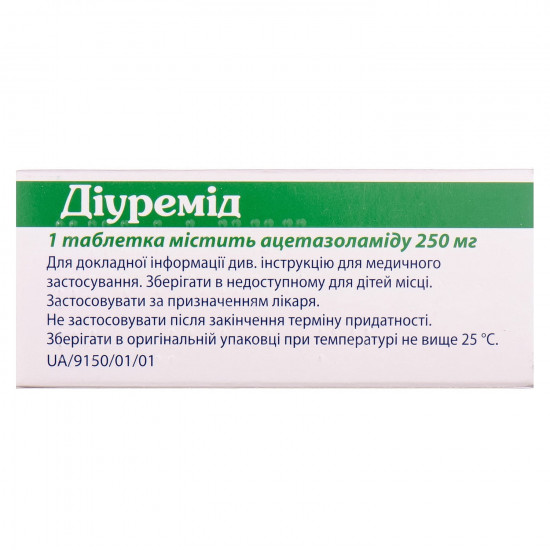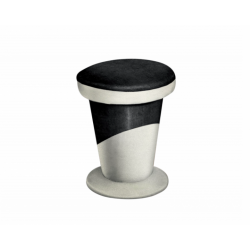



- Stock: In Stock
- Model: 179675
0% Customers recommend this product
-
5 Awesome0%
-
4 Great0%
-
3 Average0%
-
2 Bad0%
-
1 Poor0%
Reviews Over Diuremid of the tab. of 250 mg No. 20
- (0)
Total Reviews (0)
click here write review to add review for this product.
Report this review.
Description
tablets "Diuremid" are applied at the following indications:
- treatment of glaucoma:
- chronic open angle glaucoma;
- secondary glaucoma;
- closed-angle glaucoma (for short-term preoperative therapy and before ophthalmologic procedures, for reduction of intraocular pressure);
- treatment of hypostases:
- at heart failure;
- hypostases, caused by use of medicines;
- treatment of epilepsy (in a combination with other anticonvulsants):
- petit mal (small attacks) at children;
- grand mal (big attacks) at adults;
- mixed form;
- treatment of a hypobaropathy (medicine reduces acclimatization time, but its influence on manifestations of this disease is insignificant).
Structure
Active ingredient - acetazoleamide (one tablet contains acetazoleamide 250 mg).
Excipients: potato starch, talc, sodium krakhmalglikolit (type A).
Contraindication
increased individual sensitivity to components of medicine and sulfonamides, an abnormal liver function and kidneys, a sharp renal failure, a liver failure, an urolithiasis (at a hypercalcuria), giperkhloremichesky acidosis, a hypopotassemia, chronic dekompensirovanny closed-angle glaucoma (for long therapy), diabetes, uraemia, insufficiency of adrenal glands, Addison's disease. Acetazoleamide should not be applied to patients with cirrhosis as it can increase risk of hepatic encephalopathy.
Route of administrationMedicine to accept
inside. Treatment of glaucoma Drug dose to determine by
individually, depending on intraocular pressure. The recommended doses for adults:
- at an open angle glaucoma - 250 mg (one tablet) 1-4 times a day (the dose over 1000 mg (4 tablets) does not increase therapeutic effectiveness);
- at secondary glaucoma - 250 mg (one tablet) each 4 hours, at some patients the therapeutic effect is observed after reception of 250 mg (one tablet) twice a day (long appointment is not shown);
- at bad attacks of closed-angle glaucoma - 250 mg (one tablet) 4 times a day.
Treatment of epilepsy
Adults and children: as a rule, 8-30 mg/kg of body weight a day. To apply a dose in 1-4 receptions. The optimum dose makes 250-1000 mg (1-4 tablets).
At simultaneous use of acetazoleamide with other anticonvulsant medicines the initial dose of the first has to make 250 mg (one tablet) a day. If necessary to raise a dose gradually. For children the dose should not exceed 750 mg a day.
Treatment of the cardiac dropsies and hypostases caused by use of medicines
Initial dose - 250 mg a day (one tablet) in the morning.
Best diuretic effect is observed byif to apply medicine every other day or in 2 days with a one-day break.
acetazoleamide to appointAt treatment of heart failure against the background of the standard therapy (for example, prescribing of cardiac glycosides of a foxglove, a low-salt diet and replenishment of deficiency of potassium).
Treatment of a hypobaropathy
Recommended day dose makes 500-1000 mg (2-4 tablets), divided into several receptions. In case of the provided fast rise on height (it is more than 500 meters in day) the recommended dose makes 1000 mg (4 tablets), divided into several receptions.
Medicine should be accepted in 24-48 hours prior to rise up, and in case of symptoms of a disease it is necessary to prolong treatment 48 more hours or more if necessary.
Feature of application
Pregnant
Acetazoleamide gets through a placental barrier. Use of medicine during pregnancy is contraindicated.
Acetazoleamide in a small amount gets into breast milk. During use of medicine the feeding by a breast should be stopped.
ChildrenMedicine to apply
to treatment of children since 3 years only as auxiliary therapy at epilepsy. Drivers
Acetazoleamide in high doses can cause drowsiness, is more rare - fatigue, dizziness, an ataxy and a disorientation. Therefore during treatment acetazoleamide should not be driven potentially dangerous mechanisms and the car.
Overdosein case of overdose violations of electrolytic balance, acidosis and violations are possible
from central nervous system (drowsiness, paresthesias); sometimes - reduction of a diuresis.
Treatment. Medicine cancellation, symptomatic therapy, at acidosis to appoint bicarbonates. The hemodialysis is effective. There is no specific antidote.
Side effectsSide reactions are most often observed by
in an initiation of treatment.
from the immune system: reactions of hypersensitivity, including anaphylactic reactions.
from nervous system and sense bodys: spasms, paresthesias, hearing disorder/sonitus, violation of flavoring feelings, headache, dizziness, irritability, depression, confusion of consciousness, ataxy; at prolonged use - a disorientation, drowsiness, violation of touch and sensitivity, the general weakness, a flaccid paralysis; in isolated cases - the feeling of hair is always on the lips, sluggish paralysis, fatigue.
from digestive tract: anorexia, nausea, vomiting, diarrhea, liver failure, hepatic colic, intestinal colic, melena, hepatitis, cholestatic jaundice, changes of indicators of function of a liver, liver necrosis.
from a metabolism: a metabolic acidosis, loss of weight, thirst, violations of electrolytic balance (at prolonged use).
from the system of blood: in some cases at prolonged use - hemolytic anemia, a leukopenia, the Agranulocytosis, thrombocytopenia, a pancytopenia, oppression of marrow, aplastic anemia, a Werlhof's disease.
from an urinary system: frequent urination, hamaturia, glucosuria, renal colic, hyponatremia, hypopotassemia, crystalluria, polyuria, renal failure, nephrolithiasis, injury of a kidney.
Acetazoleamide as derivative sulfonamide, can cause the side reactions characteristic of sulfonamides.
from skin and mucous membranes: skin rash, itch, erythema, small tortoiseshell, multiformny erythema, Stephens-Johnson's syndrome, Lyell's disease.
Storage conditionsto Store
in original packing at a temperature not above 25 °C, out of children's reach.
Expiration date - 3 years.
Specifications
| Characteristics | |
| Active ingredients | Acetazoleamide |
| Amount of active ingredient | 250 mg |
| Applicant | Kiev vitamin plant |
| Code of automatic telephone exchange | S01EC01 Acetazoleamide |
| Interaction with food | It doesn't matter |
| Light sensitivity | Not sensitive |
| Market status | The branded generic |
| Origin | Chemical |
| Prescription status | According to the prescription |
| Primary packing | blister |
| Producer | KIEV VITAMIN PLANT OF THE JOINT-STOCK COMPANY |
| Quantity in packing | 20 tablets (2 blisters on 10 pieces) |
| Release form | tablets for internal use |
| Route of administration | Oral |
| Sign | Domestic |
| Storage temperature | from 5 °C to 25 °C |
| Trade name | Diuremid |



















































